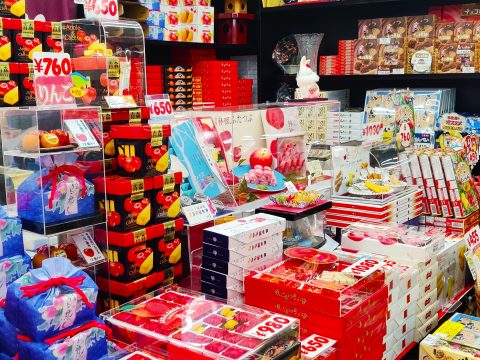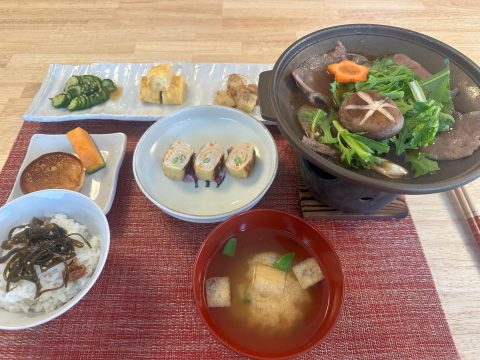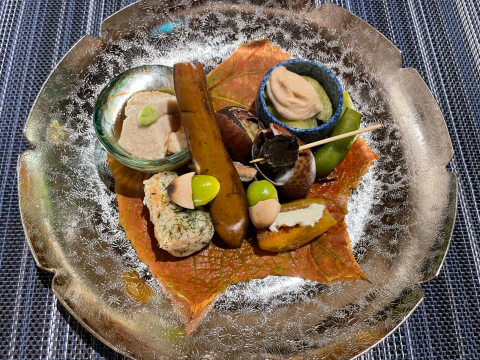Setsubun(節分)
JAPANESE FOODS
25.02.2025
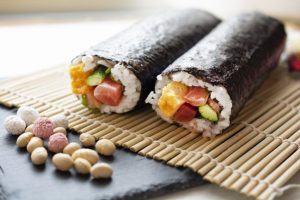
Among the many traditional holidays that Japan has, Setsubun might be one of the lesser known. So let’s have a look at the origin of this holiday and which food is involved in celebrating this day.
What is Setsubun?
Setsubun (節分) literally means ‘seasonal division’ and marks the end of winter, as it is held on the 3rd of February. The day after Setsubun is called ‘Risshun(立春)’, the first day of spring, according to the ancient calendar. On Setsubun, people all over Japan eat ‘ehomaki’ and perform ‘mame maki’, a ritual to cleanse the house and drive away evil.

Ehomaki
Simply said, an ehomaki is a long sushi roll. Eating it in silence is said to bring good luck. It shouldn’t be cut or left unfinished and is simply eaten while holding it with your hands. In addition, it should be eaten while facing the ‘lucky direction’ of that year. For 2025, the lucky direction is west-southwest. The lucky direction is usually announced in December of the previous year and is determined according to the ancient Lunar calendar. Around this time, shops will also start taking reservations for their ehomaki. Although it can also be made at home, many people will order ehomaki in advance from small shops, supermarkets or department stores. While it was first a famous tradition only in Osaka, Seven-Eleven started selling ehomaki in other regions from 1989. Eventually other convenience stores and supermarkets started selling them and by the early 2000’s this custom was spread all over Japan.

Although an ehomaki can have many different ingredients and there are no rules regarding this, popular ingredients are: eel, shiitake mushrooms, omelette, shrimp, and cucumber. This then gets rolled into rice and seaweed. It’s common to use seven different ingredients, representing the Seven Gods of Fortune, who in Japan are known to bring different types of good luck.
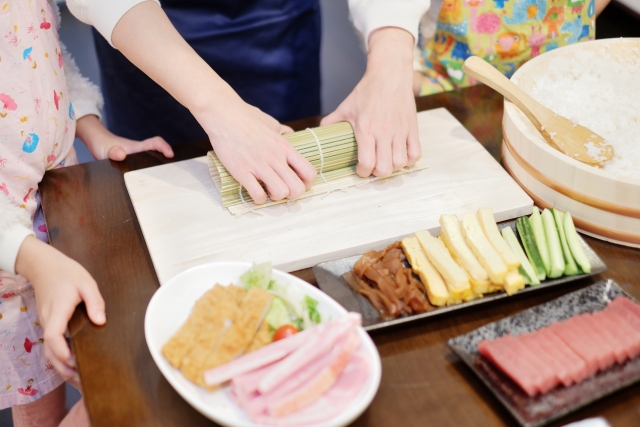
Bean Throwing Ritual
Another tradition during Setsubun, is ‘make maki’. This is a ritual to purify one’s home by driving away bad luck and evil spirits. To perform this ritual, a family member will wear a mask or even a costume of an ‘oni’ which is a demon. Other family members will then throw beans at the ‘oni’ and shout “Oni wa soto! Fuku wa uchi!” which means “Demons outside, Luck inside!”. Even without an oni, you can throw these beans outside the door, to get rid of demons and bad luck. Of course, a special ritual like this, needs special beans. These are roasted soybeans and are called ‘fuku mame’, meaning “fortune beans”.

Even though Setsubun has passed, you can still celebrate it at home and invite good luck into your life. Why not embrace the tradition and refresh your spirit with some simple rituals? Try these rituals at home and pray for good luck and fortune while enjoying a delicious ehomaki.
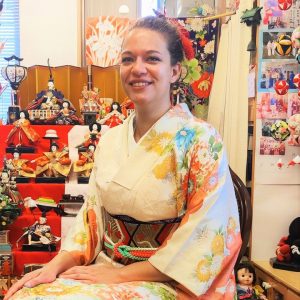
Mietta Varszegi
Mietta grew up in the Netherlands and moved to Japan in 2019 to work as an English teacher. Now, she has 3 different jobs, explores Tokyo on days off and takes trips around Japan whenever she can. But everywhere in Japan, the goal is the same: visit as many shrines, castles and parks as possible and eat everything!
Read previous articles by the writer
Read latest articles
KEYWORDS
- # PICKPICK
- # Resume
- # alcohol
- # Rice
- # Soup
- # winter food
- # Fast Food
- # seafood
- # spicy foods
- # raw food
- # fermented food
- # Transportation
- # MEAT
- # Edo culture
- # suits
- # clothing
- # drink
- # fish
- # seasoning
- # Japanese New Years Foods
- # Toshikoshi soba
- # Osechi Ryori
- # Ozoni
- # Christmas
- # Japanese fusion pasta
- # Wafu Pasta
- # Japanese Hot Pot
- # なべ
- # 鍋
- # Miyazaki
- # Chicken Nanban
- # Karamen
- # Autumn Wagashi
- # Mushi-yokan
- # Imo-yokan
- # Japanese Autumn Fruits
- # Autumn
- # Vending Machine
- # fall
- # dango
- # Chestnut rice
- # saury
- # Mushroom
- # Rice vinegar
- # Japanese condiments
- # 調味料
- # Sake
- # Mirin
- # Soy sauce
- # Japanese Noodles
- # Udon
- # Ramen
- # Yakisoba
- # Soba
- # Japanese Seaweed
- # 海藻
- # かいそう
- # Payslip
- # Training
- # Japanese summer foods
- # 和菓子
- # Wagashi
- # ryokucha
- # 夏
- # 飲み物
- # Ramune
- # ラムネ
- # Pokari Sweat
- # ポカリスエット
- # Calpis
- # カルピス
- # Mugicha
- # ume
- # 梅
- # うめ
- # umeshu
- # job hunting
- # tofu
- # Recruitment in Japan
- # miso
- # Japanese cuisine
- # Yellowtail and bonito
- # Children’s Day
- # Kashiwa Mochi
- # Chimaki
- # fruits
- # Kusamochi
- # Types of Agriculture in Japan
- # bread
- # パン
- # パン屋さん
- # japanese bread
- # shokupan
- # meal blead
- # anko bread
- # 桜
- # さくら
- # cherry blossom
- # visa
- # hanami
- # omotenashi
- # sakura
- # おもてなし
- # Japanese hospitality
- # oshibori
- # wet hand towel
- # hand towel
- # restaurant
- # Commuting in Japan
- # Women-only cars
- # Exit gate
- # japanese train
- # train
- # valentine
- # Japanese sweets
- # 朝食
- # Japanese Breakfast
- # Breakfast
- # Japanese
- # 日本
- # healthy
- # persimmons
- # hoshigaki
- # HR
- # work in Japan
- # jinji ido
- # corporate systems
- # Japanese work culture
- # bento
- # ekiben
- # shinkansen
- # omiyage
- # train station
- # Japanese culture
- # work culture
- # mentaiko
- # umeboshi
- # Japanese snacks
- # potato chips
- # Japanese potato chips
- # Japanese writing
- # seaweed
- # konbu
- # ocean foods
- # shio konbu
- # dashi
- # miso soup
- # food processing
- # pear
- # nashi
- # sweet potato
- # japanese sweet potato
- # stingray
- # satsuma imo
- # food value chain
- # homecooking
- # agriculture
- # Japanese homecooking
- # farming
- # nikujaga
- # shojin ryori
- # meat and potatoes
- # traditional foods
- # comfort food
- # buddhist food
- # manufacturing
- # factory
- # eihire
- # vegetarian
- # food and beverage
- # izakaya
- # yatai
- # japanese festival
- # taiyaki
- # matsuri
- # summer
- # Ikayaki
- # smart agriculture
- # shaved ice
- # kakigori
- # かき氷
- # summer dessert
- # Japan
- # Japanese foods
- # dessert
- # fruit
- # matcha
- # icecream
- # Pikcup
- # Pikc up
- # Pcikup
- # skilled labor visa
- # working visa japan
- # Dineer Table in Japan
- # Japanese manner
- # Japanese food
- # Japanese Table Manner
- # Chopsticks
- # Japanese traffic signs
- # traffic information
- # road rules in Japan
- # chocolate
- # green tea
- # Osaka
- # Work Japan
- # Japanese company
- # ikura
- # sushi
- # nigiri
- # wasabi
- # PCIK
- # PICK UP
- # PICK
- # PICKUP


